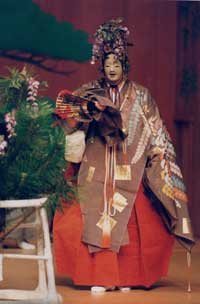
Although not as abundantly as temples and shrines there are still a lot of Noh theatres scattered around in Kyoto, an indication for it’s continuing importance as an art form.
Noh is a chanted drama that evolved in the 14th century out of various popular and aristocratic art forms. The subject of a Noh play is usually taken from a famous historical story or classical Japanese literature. Somewhere in November the Noh-club of Kyoto University organized a play, which attracted a lot of foreigners who seized the opportunity to see Noh for free. The performance of the Noh club can faithfully be described as “contemporary” Noh because besides the male Japanese actors, who are the only actors in traditional Noh, there were also actresses and a foreign student. The fact that the women roles were now really performed by women and not by men gave a different flavour to the Noh-play. The responses of the audience on the play differed, some left the theatre early, some felt asleep during the whole play, some fought their sleep and there were people who tried to get as much out it as possible.
Although I was one of those slackers who bravely fought against the comfortable feeling of dozing off I was still impressed of their performance and thus wanted to go with some friends to a professional play. The choice was a joint performance by the Kanze and Kongou schools, 2 of the 5 major Noh schools. The total performance consisted out of 6 dances, 2 Noh plays and a Kyogen play. The dance is one of the important elements in a Noh-play, and the dances are the main dances of certain plays which are performed solely derived from their context. The actors don't wear their costumes and masks and their performance is not accompanied by a choir, only by instruments.. The 2 Noh plays are the major plays while the Kyogen is a comic interlude inbetween. This time we were one of the few foreigners and we were definitely young in a audience which mostly consisted out of people in the autumn of their years.
Again seated in a too comfortable chair, my attention was this time whole heartily drawn towards the stage where people in beautiful costumes pronounced in a slowed down speed pre-modern Japanese, making it fairly impossible to follow what they are saying if you do not have it written down in modern Japanese. But because of this somehow twisted way of speaking and singing in one, they are able to do give their language a deeper layer, one with emotion. I was marvelled by the ability these actors have to express emotion with their emotionless masks. With a lack of attributes the actors still fill whole the stage with their presence and take you with them to the stories that they are representing, although not in a real realistic sense. The actors are accompanied by traditional Japanese instrument and by a choir, that not only follows the actors movements but is also an indicator for the events that are going to happy. They are really important in creating a special kind of atmosphere in the theatre.
From the beginning being in a Noh-theatre feels different from being in a normal theatre, because of it’s stage, that looks like a temple under a starry night. And as public you are part of the environment in which the play takes part. The Kyogen is a humorous play that is based on the power of exaggeration and repeating. The physical part of the jokes I could understand but unfortunately a number of playful jokes with the language didn’t get through. Te dances were in the student play one of the most uninterested parts, in which the majority of the people indulged in other businesses, they made the strongest impression on me this time. The actors this time being without mask still hold their head in such a way that it looks like a mask and still they were able to transmit emotions, at least to me. While normally seldom stirred by a dance, two of the six dances made a real impression on me in the sense that I can still see parts of them if I think of them and close my eyes.
And thus in some strange way Noh and especially it’s dances have captured a part of my heart.


